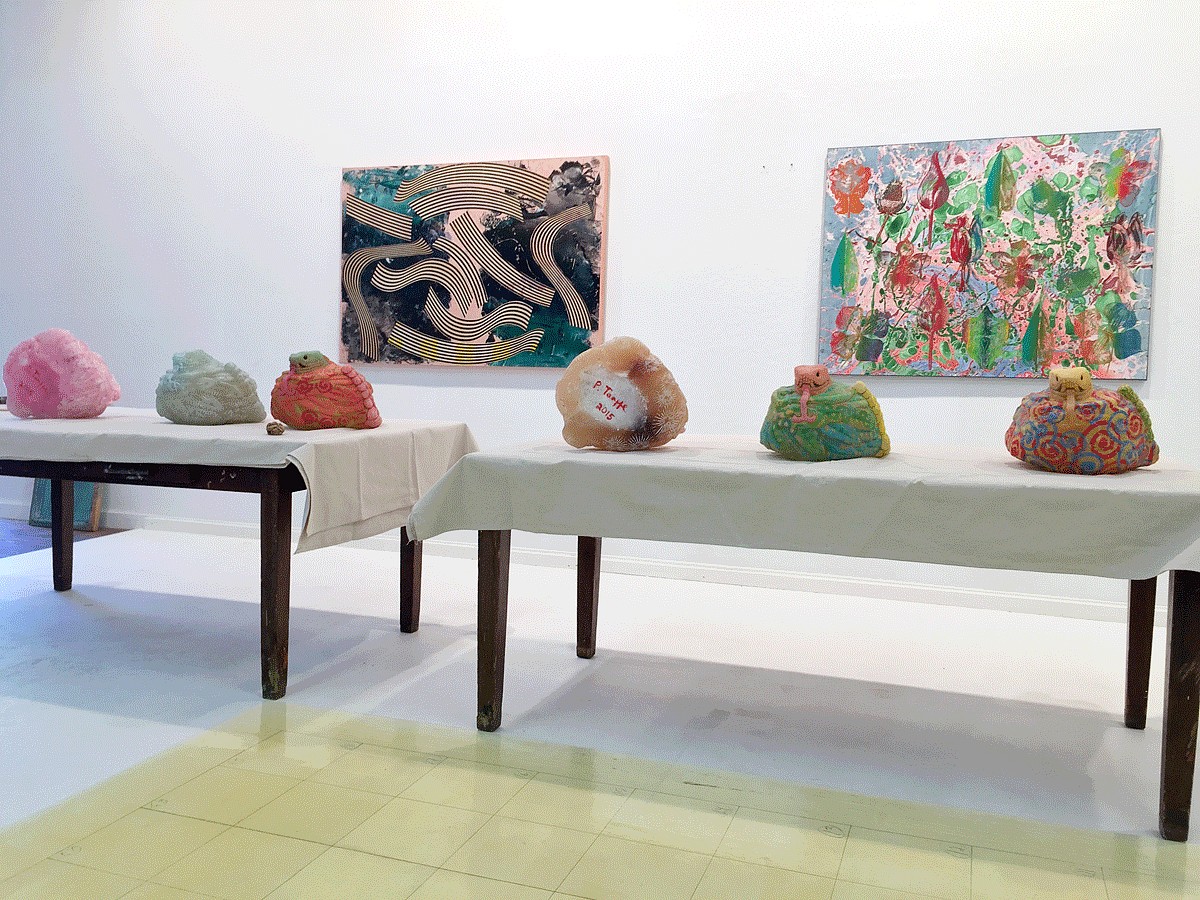PRESS RELEASE

Philip Taaffe: Hodie Mihi, Cras Tibi
by Sydelle Rubin-Dienstfrey
Inspired by an Aztec volcanic stone rendering of Quetzalcoatl (“Feathered Serpent” in the Nahuatl language), Philip Taaffe has created his first sculptural work entitled Hodie Mihi, Cras Tibi (2015). In this series, Taaffe has re-envisioned the Pre-Columbian deity revered as lord of wind and sky. Upon hand carved luminous Spanish alabaster figures, Taaffe has hand stamped and hand painted each plumed snake with his unique palette and designs, breathing new life into an ancient entity. Taaffe’s process draws upon the spiritual motivation of the ancients of the Americas. Galvanized by Pre-Columbian shaman traditions, Taaffe aims to bring out the divine Quetzalcoatl’s underlying magical and animistic qualities, transcend cultural and chronological boundaries, and imbue his pieces with a universal iconicity.
In addition to the spiritual realm, Taaffe’s inspiration for this series stems from his enduring study of Pre-Columbian art and archaeology. Taaffe’s travels in Mexico and South America as well as time spent at Harvard University’s Peabody Museum, pouring through archaeological tomes featuring large-format photographs of landmark findings achieved under the most challenging of circumstances, fueled his interpretations. The earliest and perhaps most impactful representations of the feathered serpent god adorn the Temple of Quetzalcoatl, in Teotihuacan, Mexico (ca. 3rd century CE), where numerous stone heads of the divine plumed snake embellish the steps of this Pre-Classic pyramid. This dragon-like creature whose body was covered with precious green feathers of the quetzal bird has captivated Taaffe for decades; so when he came upon the dramatic Aztec sculpture now in his personal collection, Taaffe had the confidence to venture beyond painting on a flat canvas and create this fine series of sculptures. In the artist’s words:
“I was immediately drawn to the idea of the plumed serpent. This animal is transcending its material boundaries. It’s an imaginary imposition, but seems equivocally plausible that a serpent could become a winged beast . . .”[1]
The pioneering artist/anthropologist Miguel Covarrubias, whose writings and illustrations on indigenous cultures of the ancient Americas continue to contribute to scholarly studies today, bolsters Taaffe’s respect for this deity with the following description:
“Quetzalcoatl stood for all that was good in this world: peace, art, wisdom, and prosperity. Disguised as an ant, he discovered maize, the staple food of the Indians, hidden under the mountain of Substance, Tonacatepetl; he also invented the arts, the sciences, and the calendar. In fact, everything connected with wisdom and culture was attributed to Quetzalcoatl.”[2]
Taaffe’s process is painstaking and meticulous. First he carefully selected a material for the sculptures, one that would depart from the volcanic stone of the original Aztec work, since his hope was that these pieces would possess more translucence. His decision to use Spanish alabaster was inspired by his personal collection of South Arabian Sabean heads carved from Egyptian alabaster. Though veined differently than the Egyptian variety, Spanish alabaster possesses the luminosity that Taaffe sought. Next, he adjusted the form of the piece from the original Aztec sculpture – balancing the scale of the eye sockets, redrawing the end of the forked tongue, fine tuning every aspect so to as to capture the power of its visage and bring the object to a state so as to maximize the impact of his elaborations to the surfaces. Taaffe stained each piece with pigment and poppy seed oil and hand painted the eyes and head. The artist then applied decorative motifs to the surfaces using a sophisticated technique involving relief prints onto Japanese Gampi paper, transferred to the sculpture. His patterns alternate between spirals, serpentine lines, and starbursts, motifs that draw from Taaffe’s earlier projects, but at the same time resonate with iconography related to the pantheon of Pre-Columbian deities. Finally, Taaffe painted and burnished each piece once again, selecting hues a few shades away from the primary colors and yet still suggestive of their universality and prismatic qualities, particularly when light passes through the sculptures.
With Hodie Mihi, Cras Tibi (2015) Philip Taaffe has captured the eternal nature of the Quetzalcoatl, transcending limitations of time and space. At first, Taaffe’s title for this series, a Latin inscription that translates, “As I am today, this will be you tomorrow” – a phrase commonly used on old European epitaphs – may seem out of place. However, recognition that as tomb guardians, ancient Quetzalcoatl sculptures were traditionally placed to accompany the deceased in the afterlife, lends meaning to this choice. For Taaffe, the title implies an eternal return, a cyclical notion that is embodied in this poetic mantra. In the final analysis, Taaffe sees these works as embodying a constructive message about every species’ ultimate demise.
“It’s a means of being optimistic about the whole concept of death and destruction. If you confront it and its unconscious position, it’s a storytelling device by which you can understand this condition better.”[3]
Indeed, in the ancient world, art was used in intimate ways throughout a person’s lifespan, in ceremonies revolving around birth, rites of passage, marriage, warfare, and death. In a similar manner, through this series Taaffe encourages viewers to engage with his art in a reflective manner, inspiring contemplation and reconciliation with the finality of life.


